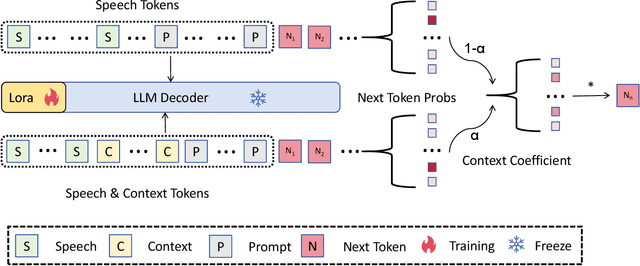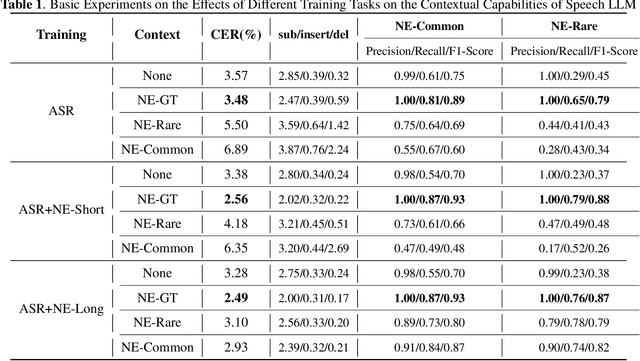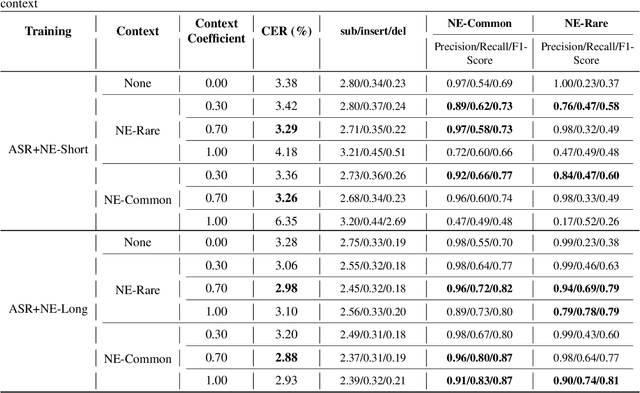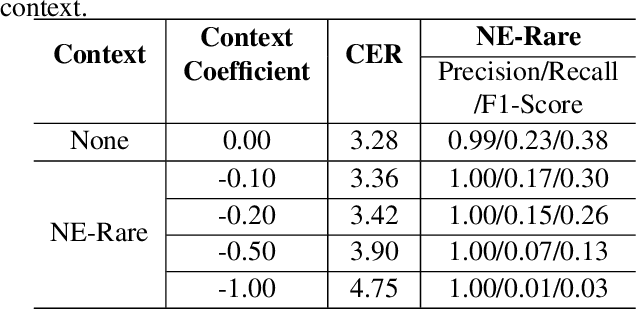Kai Yu
Sherman
Omni-Captioner: Data Pipeline, Models, and Benchmark for Omni Detailed Perception
Oct 14, 2025Abstract:Fine-grained perception of multimodal information is critical for advancing human-AI interaction. With recent progress in audio-visual technologies, Omni Language Models (OLMs), capable of processing audio and video signals in parallel, have emerged as a promising paradigm for achieving richer understanding and reasoning. However, their capacity to capture and describe fine-grained details remains limited explored. In this work, we present a systematic and comprehensive investigation of omni detailed perception from the perspectives of the data pipeline, models, and benchmark. We first identify an inherent "co-growth" between detail and hallucination in current OLMs. To address this, we propose Omni-Detective, an agentic data generation pipeline integrating tool-calling, to autonomously produce highly detailed yet minimally hallucinatory multimodal data. Based on the data generated with Omni-Detective, we train two captioning models: Audio-Captioner for audio-only detailed perception, and Omni-Captioner for audio-visual detailed perception. Under the cascade evaluation protocol, Audio-Captioner achieves the best performance on MMAU and MMAR among all open-source models, surpassing Gemini 2.5 Flash and delivering performance comparable to Gemini 2.5 Pro. On existing detailed captioning benchmarks, Omni-Captioner sets a new state-of-the-art on VDC and achieves the best trade-off between detail and hallucination on the video-SALMONN 2 testset. Given the absence of a dedicated benchmark for omni detailed perception, we design Omni-Cloze, a novel cloze-style evaluation for detailed audio, visual, and audio-visual captioning that ensures stable, efficient, and reliable assessment. Experimental results and analysis demonstrate the effectiveness of Omni-Detective in generating high-quality detailed captions, as well as the superiority of Omni-Cloze in evaluating such detailed captions.
Bitrate-Controlled Diffusion for Disentangling Motion and Content in Video
Sep 10, 2025Abstract:We propose a novel and general framework to disentangle video data into its dynamic motion and static content components. Our proposed method is a self-supervised pipeline with less assumptions and inductive biases than previous works: it utilizes a transformer-based architecture to jointly generate flexible implicit features for frame-wise motion and clip-wise content, and incorporates a low-bitrate vector quantization as an information bottleneck to promote disentanglement and form a meaningful discrete motion space. The bitrate-controlled latent motion and content are used as conditional inputs to a denoising diffusion model to facilitate self-supervised representation learning. We validate our disentangled representation learning framework on real-world talking head videos with motion transfer and auto-regressive motion generation tasks. Furthermore, we also show that our method can generalize to other types of video data, such as pixel sprites of 2D cartoon characters. Our work presents a new perspective on self-supervised learning of disentangled video representations, contributing to the broader field of video analysis and generation.
POSE: Phased One-Step Adversarial Equilibrium for Video Diffusion Models
Aug 28, 2025



Abstract:The field of video diffusion generation faces critical bottlenecks in sampling efficiency, especially for large-scale models and long sequences. Existing video acceleration methods adopt image-based techniques but suffer from fundamental limitations: they neither model the temporal coherence of video frames nor provide single-step distillation for large-scale video models. To bridge this gap, we propose POSE (Phased One-Step Equilibrium), a distillation framework that reduces the sampling steps of large-scale video diffusion models, enabling the generation of high-quality videos in a single step. POSE employs a carefully designed two-phase process to distill video models:(i) stability priming: a warm-up mechanism to stabilize adversarial distillation that adapts the high-quality trajectory of the one-step generator from high to low signal-to-noise ratio regimes, optimizing the video quality of single-step mappings near the endpoints of flow trajectories. (ii) unified adversarial equilibrium: a flexible self-adversarial distillation mechanism that promotes stable single-step adversarial training towards a Nash equilibrium within the Gaussian noise space, generating realistic single-step videos close to real videos. For conditional video generation, we propose (iii) conditional adversarial consistency, a method to improve both semantic consistency and frame consistency between conditional frames and generated frames. Comprehensive experiments demonstrate that POSE outperforms other acceleration methods on VBench-I2V by average 7.15% in semantic alignment, temporal conference and frame quality, reducing the latency of the pre-trained model by 100$\times$, from 1000 seconds to 10 seconds, while maintaining competitive performance.
MOSA: Mixtures of Simple Adapters Outperform Monolithic Approaches in LLM-based Multilingual ASR
Aug 26, 2025



Abstract:End-to-end multilingual ASR aims to transcribe speech from different languages into corresponding text, but is often limited by scarce multilingual data. LLM-based ASR aligns speech encoder outputs with LLM input space via a projector and has achieved notable success. However, prior work mainly improves performance by increasing data, with little focus on cross-lingual knowledge sharing. Moreover, a single complex projector struggles to capture both shared and language-specific features effectively. In this work, we propose MOSA (Mixture of Simple Adapters), leveraging a Mixture-of-Experts mechanism to combine lightweight adapters that learn shared and language-specific knowledge. This enables better utilization of high-resource language data to support low-resource languages, mitigating data scarcity issues. Experimental results show that MOSA-Base achieves a 15.4\% relative reduction in average WER compared to the Baseline-Base and consistently outperforms it across all languages. Remarkably, MOSA-Base surpasses the Baseline-Base even when trained with only 60\% of its parameters. Similarly, MOSA-Large outperforms the Baseline-Large in average WER and demonstrates greater robustness to data imbalance. Ablation studies further indicate that MOSA is more effective at handling individual languages and learning both language-specific and shared linguistic knowledge. These findings support that, in LLM-based ASR, a mixture of simple adapters is more effective than a single, complex adapter design.
Joint decoding method for controllable contextual speech recognition based on Speech LLM
Aug 12, 2025



Abstract:Contextual speech recognition refers to the ability to identify preferences for specific content based on contextual information. Recently, leveraging the contextual understanding capabilities of Speech LLM to achieve contextual biasing by injecting contextual information through prompts have emerged as a research hotspot.However, the direct information injection method via prompts relies on the internal attention mechanism of the model, making it impossible to explicitly control the extent of information injection. To address this limitation, we propose a joint decoding method to control the contextual information. This approach enables explicit control over the injected contextual information and achieving superior recognition performance. Additionally, Our method can also be used for sensitive word suppression recognition.Furthermore, experimental results show that even Speech LLM not pre-trained on long contextual data can acquire long contextual capabilities through our method.
ChemDFM-R: An Chemical Reasoner LLM Enhanced with Atomized Chemical Knowledge
Jul 30, 2025Abstract:While large language models (LLMs) have achieved impressive progress, their application in scientific domains such as chemistry remains hindered by shallow domain understanding and limited reasoning capabilities. In this work, we focus on the specific field of chemistry and develop a Chemical Reasoner LLM, ChemDFM-R. We first construct a comprehensive dataset of atomized knowledge points to enhance the model's understanding of the fundamental principles and logical structure of chemistry. Then, we propose a mix-sourced distillation strategy that integrates expert-curated knowledge with general-domain reasoning skills, followed by domain-specific reinforcement learning to enhance chemical reasoning. Experiments on diverse chemical benchmarks demonstrate that ChemDFM-R achieves cutting-edge performance while providing interpretable, rationale-driven outputs. Further case studies illustrate how explicit reasoning chains significantly improve the reliability, transparency, and practical utility of the model in real-world human-AI collaboration scenarios.
Reasoning-Driven Retrosynthesis Prediction with Large Language Models via Reinforcement Learning
Jul 23, 2025Abstract:Retrosynthesis planning, essential in organic synthesis and drug discovery, has greatly benefited from recent AI-driven advancements. Nevertheless, existing methods frequently face limitations in both applicability and explainability. Traditional graph-based and sequence-to-sequence models often lack generalized chemical knowledge, leading to predictions that are neither consistently accurate nor easily explainable. To address these challenges, we introduce RetroDFM-R, a reasoning-based large language model (LLM) designed specifically for chemical retrosynthesis. Leveraging large-scale reinforcement learning guided by chemically verifiable rewards, RetroDFM-R significantly enhances prediction accuracy and explainability. Comprehensive evaluations demonstrate that RetroDFM-R significantly outperforms state-of-the-art methods, achieving a top-1 accuracy of 65.0% on the USPTO-50K benchmark. Double-blind human assessments further validate the chemical plausibility and practical utility of RetroDFM-R's predictions. RetroDFM-R also accurately predicts multistep retrosynthetic routes reported in the literature for both real-world drug molecules and perovskite materials. Crucially, the model's explicit reasoning process provides human-interpretable insights, thereby enhancing trust and practical value in real-world retrosynthesis applications.
Text to Image for Multi-Label Image Recognition with Joint Prompt-Adapter Learning
Jun 12, 2025



Abstract:Benefited from image-text contrastive learning, pre-trained vision-language models, e.g., CLIP, allow to direct leverage texts as images (TaI) for parameter-efficient fine-tuning (PEFT). While CLIP is capable of making image features to be similar to the corresponding text features, the modality gap remains a nontrivial issue and limits image recognition performance of TaI. Using multi-label image recognition (MLR) as an example, we present a novel method, called T2I-PAL to tackle the modality gap issue when using only text captions for PEFT. The core design of T2I-PAL is to leverage pre-trained text-to-image generation models to generate photo-realistic and diverse images from text captions, thereby reducing the modality gap. To further enhance MLR, T2I-PAL incorporates a class-wise heatmap and learnable prototypes. This aggregates local similarities, making the representation of local visual features more robust and informative for multi-label recognition. For better PEFT, we further combine both prompt tuning and adapter learning to enhance classification performance. T2I-PAL offers significant advantages: it eliminates the need for fully semantically annotated training images, thereby reducing the manual annotation workload, and it preserves the intrinsic mode of the CLIP model, allowing for seamless integration with any existing CLIP framework. Extensive experiments on multiple benchmarks, including MS-COCO, VOC2007, and NUS-WIDE, show that our T2I-PAL can boost recognition performance by 3.47% in average above the top-ranked state-of-the-art methods.
Low-Resource Domain Adaptation for Speech LLMs via Text-Only Fine-Tuning
Jun 06, 2025Abstract:Recent advances in automatic speech recognition (ASR) have combined speech encoders with large language models (LLMs) through projection, forming Speech LLMs with strong performance. However, adapting them to new domains remains challenging, especially in low-resource settings where paired speech-text data is scarce. We propose a text-only fine-tuning strategy for Speech LLMs using unpaired target-domain text without requiring additional audio. To preserve speech-text alignment, we introduce a real-time evaluation mechanism during fine-tuning. This enables effective domain adaptation while maintaining source-domain performance. Experiments on LibriSpeech, SlideSpeech, and Medical datasets show that our method achieves competitive recognition performance, with minimal degradation compared to full audio-text fine-tuning. It also improves generalization to new domains without catastrophic forgetting, highlighting the potential of text-only fine-tuning for low-resource domain adaptation of ASR.
Masked Self-distilled Transducer-based Keyword Spotting with Semi-autoregressive Decoding
May 30, 2025Abstract:RNN-T-based keyword spotting (KWS) with autoregressive decoding~(AR) has gained attention due to its streaming architecture and superior performance. However, the simplicity of the prediction network in RNN-T poses an overfitting issue, especially under challenging scenarios, resulting in degraded performance. In this paper, we propose a masked self-distillation (MSD) training strategy that avoids RNN-Ts overly relying on prediction networks to alleviate overfitting. Such training enables masked non-autoregressive (NAR) decoding, which fully masks the RNN-T predictor output during KWS decoding. In addition, we propose a semi-autoregressive (SAR) decoding approach to integrate the advantages of AR and NAR decoding. Our experiments across multiple KWS datasets demonstrate that MSD training effectively alleviates overfitting. The SAR decoding method preserves the superior performance of AR decoding while benefits from the overfitting suppression of NAR decoding, achieving excellent results.
 Add to Chrome
Add to Chrome Add to Firefox
Add to Firefox Add to Edge
Add to Edge